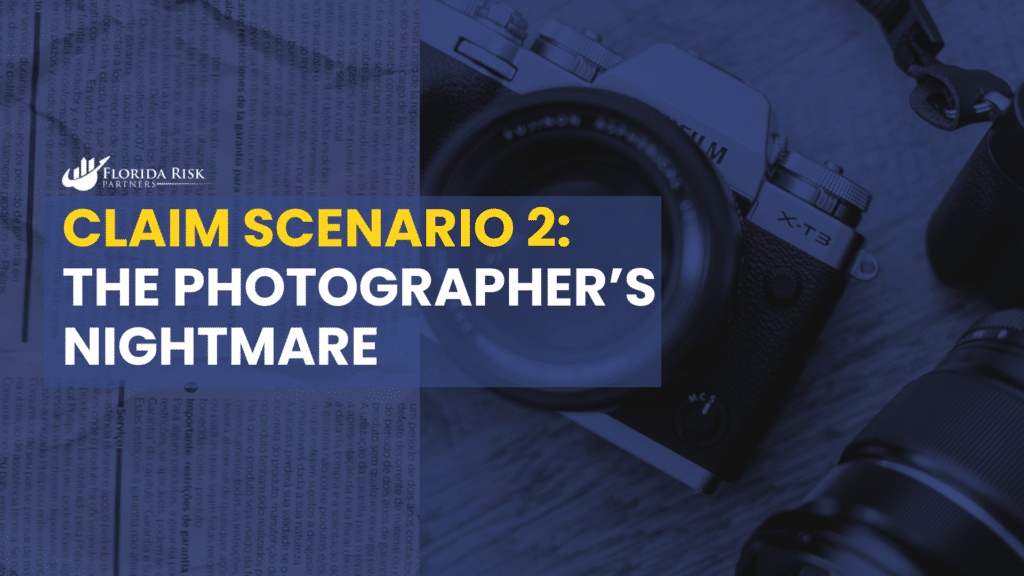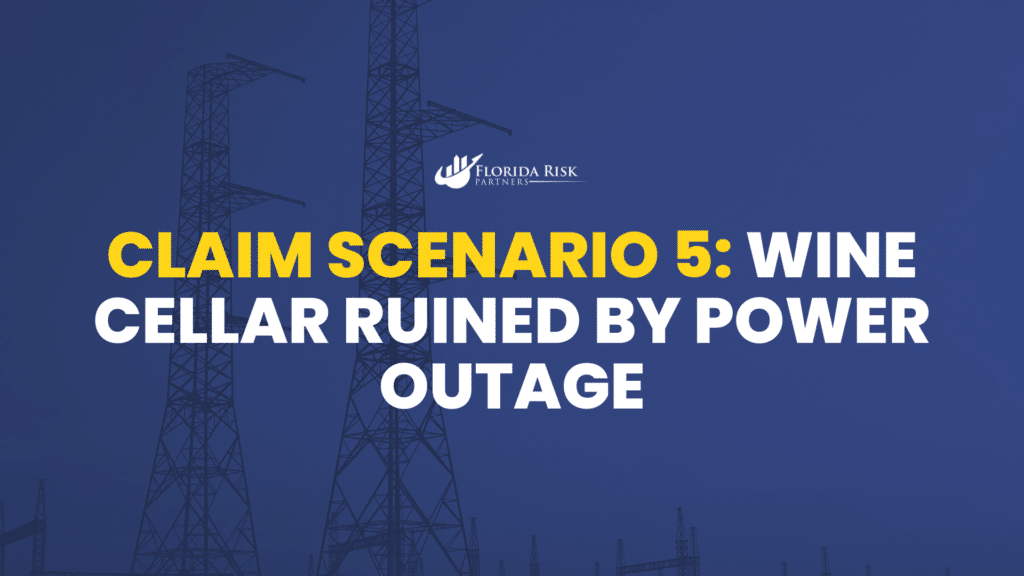-
Main Office: 1434 E. Bloomingdale Ave Valrico, FL 33596-6110
-
Phone: (888) 601-6660
-
Email: info@floridariskpartners.com

Insurance is one of those things that we often don’t think about until we need it. For most people, it’s out of sight and out of mind—until something valuable is lost, stolen, or destroyed. That’s when the reality of coverage limitations can hit hard. And in those moments, the difference between having a standard homeowners insurance policy and a Personal Articles Floater (PAF) becomes incredibly clear.
This week, as we continue our 12-part series on personal articles floaters, we’re bringing the concept to life by sharing real-life claim scenarios. These are not hypothetical examples; they are situations homeowners and policyholders have actually faced—some who were properly protected, and others who learned painful lessons the hard way.
Our goal is simple: to help you understand how claims are handled, where coverage gaps appear, and how a PAF could have (or did) make all the difference.
The Reality of Claims: Why Floaters Matter More Than You Think
Before diving into the stories, let’s recap why personal articles floaters exist in the first place. A standard homeowners policy includes Coverage C – Personal Property, which insures your belongings up to a certain limit. However, that coverage is subject to category-specific sublimits, depreciation, actual cash value, and a list of exclusions that can significantly reduce or deny payment in the event of a loss.
A Personal Articles Floater provides scheduled coverage for specific items at an agreed value. It typically offers:
- Worldwide protection
- No deductible
- Coverage for mysterious disappearance
- Replacement cost or agreed value settlements
- Fewer disputes in the claims process
Let’s explore some real stories that show why this coverage is so essential.
Claim Scenario 1: The Disappearing Diamond Ring
The Situation:
Emily was on vacation in the Caribbean with her family. One afternoon, while swimming in the ocean, she noticed her diamond engagement ring had slipped off her finger. After hours of searching, she had to accept that it was gone for good.
The Policy:
Emily had a standard homeowners insurance policy with a $1,500 sublimit for jewelry theft—but not for mysterious disappearance or loss.
The Outcome:
Because the ring wasn’t stolen and there was no evidence of theft, her homeowners insurance denied the claim. Emily was devastated—not only because she lost a symbol of her marriage, but also because she had no financial help to replace it. The ring had been appraised at over $9,000.
What Could Have Helped:
If Emily had scheduled the ring on a Personal Articles Floater, the policy would have covered the full value of the ring with no deductible, regardless of how it was lost. Mysterious disappearance is a covered peril on most floaters, making this a textbook example of why they’re so valuable.
Claim Scenario 2: The Photographer’s Nightmare

The Situation:
Derek, a freelance photographer, was on assignment at a national park. After capturing a series of shots with his $7,500 DSLR setup, he packed up and headed to lunch. When he returned to his vehicle, the window was shattered and all his camera equipment was gone.
The Policy:
Derek filed a claim with his homeowners insurance. But because his photography generated income—and the equipment was considered used for business purposes—his claim was denied. The insurer cited the business-use exclusion in his policy.
The Outcome:
Derek was left with no reimbursement and had to dip into his savings to replace his gear in order to continue working.
What Could Have Helped:
A Personal Articles Floater could have covered the camera and lenses regardless of where they were used, especially if the policyholder had disclosed their freelance work to the agent. Some carriers offer endorsements for professional equipment, or allow hobby/business hybrids to be floated, depending on the use. The key is communication and proper scheduling.
Claim Scenario 3: Antique Heirloom Furniture Destroyed in Fire
The Situation:
Mike and Joanna’s home was partially destroyed in a fire. Among the losses was a set of antique bedroom furniture that had been passed down through three generations. The set had been professionally appraised at $18,000 two years prior.
The Policy:
Their homeowners policy provided personal property coverage at replacement cost, but only for standard household items. Antiques, fine art, and collectibles were not scheduled separately, and were subject to actual cash value, not replacement cost.
The Outcome:
The claims adjuster valued the furniture set at $2,800 due to depreciation and age. Mike and Joanna were stunned. Not only were they grieving the loss of something sentimental, but they were also underinsured by more than $15,000.
What Could Have Helped:
If the antique furniture had been properly scheduled on a floater, the appraisal value could have been used as the agreed settlement amount, avoiding depreciation entirely. A PAF would have ensured that the sentimental and market value of the items were both protected.
Claim Scenario 4: Theft of Designer Handbags from Luggage
The Situation:
Lena, a fashion blogger, returned from a European trip to find that her checked luggage was missing. Inside were three high-end designer handbags, including a rare limited-edition bag valued at $6,500.
The Policy:
Her homeowners policy had an off-premises coverage clause, but it limited reimbursement for luxury accessories to $1,500 total. Additionally, she had no documentation of the bags’ purchase or value.
The Outcome:
Lena received only $1,200 from the claim. The insurer explained that without receipts or itemized coverage, there was no basis for higher payment. The loss was devastating both financially and emotionally.
What Could Have Helped:
Scheduling each handbag on a floater, with documented appraisals or receipts, would have ensured full replacement value regardless of where the loss occurred. Floaters include worldwide coverage and aren’t subject to the off-premises limits found in homeowners policies.
Claim Scenario 5: Wine Cellar Ruined by Power Outage

The Situation:
Tom had spent years curating a wine collection valued at over $25,000. A sudden power outage during a storm knocked out his temperature-controlled wine cellar for three days while he was out of town. When he returned, most of the bottles had been spoiled due to heat exposure.
The Policy:
His homeowners insurance denied the claim, citing exclusions for perishable items and temperature-related spoilage.
The Outcome:
Tom was forced to absorb the entire loss, which included rare vintages he could not replace.
What Could Have Helped:
A Personal Articles Floater specifically tailored for wine collections could have included protection for temperature control failure. These specialized floaters can be customized for wine, spirits, cigars, or other climate-sensitive collections, providing coverage for exactly this type of scenario.
What These Stories Teach Us
Each of these scenarios highlights a different exposure—but they all have one thing in common: the failure of standard homeowners insurance to provide adequate protection for high-value personal property.
The key takeaways from these claims are:
- Documentation Matters: Photos, receipts, and appraisals are critical when it comes to proving ownership and value.
- Floaters Avoid Depreciation: Personal Articles Floaters typically use agreed value or replacement cost, eliminating depreciation deductions that can drastically reduce payouts.
- Coverage Goes Wherever You Go: Whether it’s a vacation, a photo shoot, or an international flight, floaters offer worldwide protection.
- Special Use Cases Need Special Coverage: Business use, collector’s value, and climate-sensitive storage all create gaps in standard coverage that can be filled with a PAF.
- Emotional Recovery Is Real: Beyond dollars and cents, being able to replace something that’s meaningful—even symbolically—can bring peace of mind and closure.
How to Avoid Becoming the Next Cautionary Tale
If these stories hit close to home, it’s not too late to take action. Here’s how you can protect yourself:
- Do an Inventory: Walk through your home and document items that would be expensive or difficult to replace.
- Get Appraisals: For jewelry, art, antiques, and collectibles, have an updated appraisal on file.
- Talk to Your Agent: Share your lifestyle, hobbies, and business activities. The more your agent knows, the better they can tailor your coverage.
- Schedule What Matters: If an item is worth more than $1,000 and carries financial or emotional significance, consider floating it.
- Keep Records Safe: Store digital and physical copies of documentation somewhere accessible and secure.
Final Thoughts
Insurance is more than a policy—it’s a promise. But that promise is only as good as the coverage behind it. As these real-life stories show, the difference between a denied claim and a full recovery often comes down to whether a Personal Articles Floater was in place.
Don’t leave it to chance. You’ve worked hard to earn, acquire, and protect the things you love. Let’s make sure your coverage is just as thoughtful.
Call Us Or
Schedule an Appointment
Select an agent below to view our online calendars and select a day and time that works best for you or call us directly at 888-601-6660. When you use our online calendars, you will receive an email with more information.



